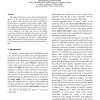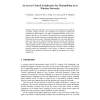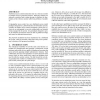JSAC
2006
14 years 3 months ago
2006
We use game theorectic models to show the lack of incentives in the TCP congestion avoidance algorithm and the consequential systemwide network problems. We then propose a Vickery-...
CSREASAM
2006
14 years 4 months ago
2006
Trust and authority are essential components that must be factored in designing and implementing a distributed access control mechanism for open environments. This paper presents ...
CCS
1994
ACM
14 years 7 months ago
1994
ACM
This paper describes an access control mechanism that enforces at the network level an access control decision that is taken at the application level. The mechanism is based on th...
IDMS
2001
Springer
14 years 7 months ago
2001
Springer
This paper introduces a novel access control architecture for publicly accessible, wireless networks. The architecture was designed to address the requirements obtained from a case...
SACMAT
2003
ACM
14 years 8 months ago
2003
ACM
Traditional access control mechanisms rely on a reference monitor to mediate access to protected resources. Reference monitors are inherently centralized and existing attempts to ...
HOTOS
2003
IEEE
14 years 8 months ago
2003
IEEE
Many types of information available in a pervasive computing environment, such as people location information, should be accessible only by a limited set of people. Some propertie...
EDBTW
2004
Springer
14 years 8 months ago
2004
Springer
Abstract. The rapid increase on the circulation of data over the web has highlighted the need for distributed storage of Internet-accessible information due to the rapid increase o...
SACMAT
2005
ACM
14 years 8 months ago
2005
ACM
As a major component of any host, or network operating system, access control mechanisms come in a wide variety of forms, each with their individual attributes, functions, methods...
CIMCA
2005
IEEE
14 years 8 months ago
2005
IEEE
Access control for shared resources is a complex and challenging task, in particular if the access control policy should be able to cope with different kind of sharing and collabo...
SOUPS
2006
ACM
14 years 9 months ago
2006
ACM
The usability of access control mechanisms in modern distributed systems has been widely criticized but little studied. In this paper, we carefully examine one such widely deploye...



